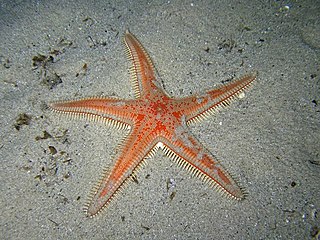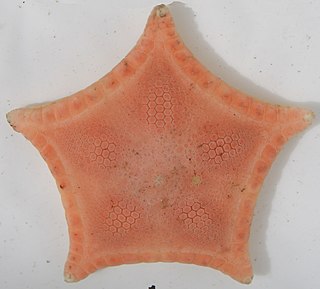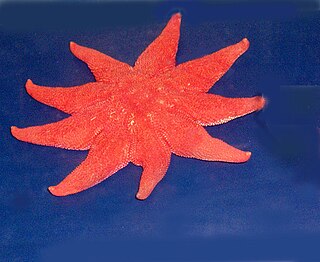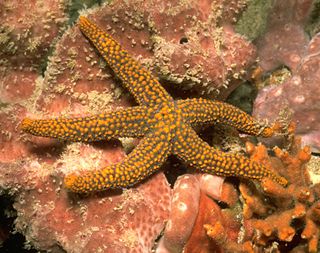
Mediaster aequalis is a species of sea star in the family Goniasteridae. It is native to the west coast of North America, ranging from Alaska to California. It is found in various habitats including beaches during very low tides, and at depths down to about 500 m (1,600 ft). Also known as the vermilion sea star, it is the type species of the genus Mediaster and was first described in 1857 by the American zoologist William Stimpson.

Solaster paxillatus, the orange sun star, is a species of starfish found at varying depths in the northern Pacific Ocean. It is a natural predator of the starfish Asterias amurensis.

Astropecten aranciacus, the red comb star, is a sea star of the family Astropectinidae. It is native to the east Atlantic Ocean and Mediterranean Sea.

Ceramaster is a genus of cushion stars in the family Goniasteridae. The species in this genus have no arms. They live in deeper waters than most sea stars.

The leather star is a sea star in the family Asteropseidae found at depths to 100 m (328 ft) off the western seaboard of North America. It was first described to science by Adolph Eduard Grube in 1857.

Astropecten irregularis is a sea star of the family Astropectinidae. Common names include Sand sea star.

Astropecten jonstoni is a sea star of the family Astropectinidae.

Solaster stimpsoni, common names Stimpson's sun star, sun star, orange sun star, striped sunstar, and sun sea star, is a species of starfish in the family Solasteridae.

Solaster dawsoni, the morning sun star, is a species of starfish in the family Solasteridae. It is found on either side of the northern Pacific Ocean. It has two subspecies:

The purple sunstar, northern sunstar, or smooth sun star, Solaster endeca, is a species of starfish in the family Solasteridae.

Evasterias troschelii is a species of starfish in the family Asteriidae. Its common names include the mottled star, false ochre sea star and Troschel's true star. It is found in Kamchatka and the north western coast of North America.

Labidiaster annulatus, the Antarctic Sun starfish or wolftrap starfish is a species of starfish in the family Heliasteridae. It is found in the cold waters around Antarctica and has a large number of slender, flexible rays.
Stylasterias is a genus of starfish in the family Asteriidae. Stylasterias forreri, the velcro star, is the only species in the genus. It is found on the Pacific coast of Canada and the United States.

Pteraster tesselatus, the slime star or cushion star, is a species of starfish in the family Pterasteridae found in the North Pacific.

The sand star, Luidia foliolata, is a species of starfish in the family Luidiidae found in the northeastern Pacific Ocean on sandy and muddy seabeds at depths to about 600 m (2,000 ft).
Ophiothrix suensoni, Suenson's brittle star or the sponge brittle star, is a species of marine invertebrate in the order Ophiurida. It is found in the Caribbean Sea and Gulf of Mexico. It is included in the subgenus Acanthophiothrix making its full scientific name Ophiothrix (Acanthophiothrix) suensoni.

The orange knobby star, Echinaster echinophorus, is a species of sea star found in the Caribbean Sea and along the Atlantic coast of South America.

Echinaster spinulosus, the small spine sea star, is a species of sea star found in shallow parts of the western Atlantic Ocean, the Caribbean Sea and Gulf of Mexico.

Ceramaster arcticus, the Arctic cookie star, is a species of sea star. It is pink and often has dark red accents. It has broad arms, no spines, and no pincers, or pedicellariae. It is considered rare and only inhabits the Pacific Ocean off the coast of northwestern North America.

Pteraster militaris, the wrinkled star, is a species of starfish in the family Pterasteridae. It is found in the northern Pacific Ocean, the Arctic Ocean, the Barents Sea and the northern Atlantic Ocean.


















